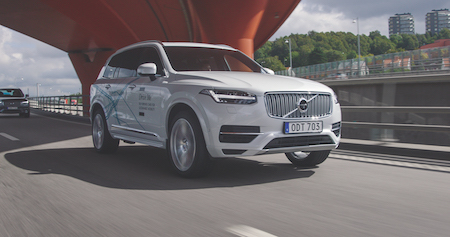Loophole
It is unclear whether key provisions of the Americans with Disabilities Act (ADA) apply to Uber’s autonomous vehicles. The ADA imposes accessibility requirements on private transportation providers, making it compulsory that all “new vans” in their fleets be accessible to individuals with disabilities. The problem is that the term “van” has never been satisfactorily defined. This issue remains unaddressed today due to taxi services sidestepping the matter by purchasing used vehicles instead of new ones, meaning few in the legal world had paid any heed to the problem of defining the word “van”.
Uber’s fleet of Volvo XC90 SUVs, however, are all new vehicles, and could well put the issue back into the spotlight, as it may well affect many other companies looking to move into the autonomous vehicles market. Making the legal distinction between an “automobile” and a “van” is now of paramount importance.
In 2011, the New York Taxi and Limousine Commission (TLC) purchased a fleet of new vehicles, opening up the debate as disability rights activists noticed the opening created by their break from the tradition of buying used vehicles. As it turned out, despite the ADA’s repeated use of the term “van” it was never sufficiently defined. Both the activists and TLC attempted to define it themselves, but to no lasting effect. In the end, TLC settled, agreeing to make their fleet wheelchair accessible by 2020, and because the issue never reached trial, the term “van” still remains unclear, though this may be answered by Uber.
Robotics Law Journal caught up with Bryan to see what has happened with the issue since his article, with Uber not showing any signs of slowing down its plans for self-driving vehicles, having tried to expand its testing base to San Francisco.
First of all, have there been any developments on this issue since you first addressed it?
There have not been any major developments regarding this issue since the article’s publication in December, except to say that even greater numbers of industry players than before have announced plans to enter the driverless transportation market in similar fashion to Uber. Autonomous taxis as a viable, mainstream transportation option, however, are still a ways off – meaning that companies like Uber and Lyft will have time to adapt accordingly, should they choose to do so. Part of my reason for raising awareness about these potentially unforeseen issues at such an early stage is to allow companies time to address them now, before it is too late to right the ship, so to speak.
Has there been any response from Uber about it?
According to Wired Magazine’s Aarian Marshall, Uber was officially notified of the story by Wired forty-eight hours in advance of its publication. But Uber chose not to comment.
Does Uber have an ethical responsibility to circumvent the loophole and ensure their fleet is easy to access for all passengers?
Uber has a responsibility to ensure that its fleet is ADA compliant – but the precise contours of that responsibility are by no means clear at this stage. That being said, it’s important to remember the benefits that companies like Uber and Lyft already afford the disability community in their current form. Tony Coelho, a leading Congressional sponsor of the ADA and, himself, a wheelchair user, is on the record stating that Uber – imperfect though it may be – is a clear positive for the disability community. And I’m inclined to agree. Even though many activists argue that Uber continues to fall short of its ADA obligations, I’d venture to guess that few among them would prefer a world without the company.
To that end, a major goal of the article was to try to change the current conversation from one of obligation to one of opportunity. It’s important to remember that companies such as Uber and Lyft are already voluntarily entering into this space because they’ve recognized that improving existing transportation services for individuals with disabilities is not only the right thing to do, it’s also profitable. Uber and Lyft have already piloted accessibility-focused service programs, have expanded driver accessibility training, and – most importantly – have begun to work with state and municipal governments to improve Medicaid-covered transportation services for individuals with disabilities.
Whether Uber, Lyft, and other transportation companies will continue this trend in the long term by incorporating accessible vehicles into their mainstream fleets, or will instead go in the direction of providing niche services (that will likely be costlier and less streamlined), remains yet to be seen. But there's undoubtedly a market. And if Uber and Lyft don’t rise to the challenge, other companies will take the market opportunity away from them. My work is, partially, an effort to point out this fact to leading transportation providers – rather than waiting for more provincial, decentralized companies or government agencies to come and pick up the pieces, as has historically been the pattern.
What is likely to happen with this in the future?
Frankly, I can't even offer an educated guess as to how this will all pan out, except to say that the issue needn’t be resolved in court. Litigation is one obvious avenue, but there are other ways of addressing the ambiguity that may obviate the need for it. The relevant sections of the ADA could be “rewritten” or amended by Congress. And though such an undertaking may seem unrealistic in light of today’s political climate, it’s important to note that the ADA was a bipartisan bill. It passed under the George H.W. Bush administration with overwhelming Republican support. Things have obviously changed since 1990, but there’s certainly cause for some optimism. An organized push for legislative action is by no means inconceivable.
Another avenue is regulatory. The relevant administrative agencies could clarify the ambiguity long before the issue went before a judicial body. But how this future, ultimately, plays out will partially be a function of the amount of media attention this issue draws. Uber caught a good deal of flak in 2014 and 2015 in response to allegations involving driver discrimination. And as more competitors enter the driverless transportation market in the coming years, the company may find it increasingly difficult to absorb public controversy without serious consumer backlash. Competition, in this sense, is good for compliance.
In my view, however, the best-case scenario is one is which ride-hailing services enter into these markets, not for fear of some kind of public sanction, but because they recognize the market potential in servicing individuals with disabilities who have, historically, been underserved. We’ll have to wait and see.


.jpg)
.jpg)
.jpg)

.jpg)




